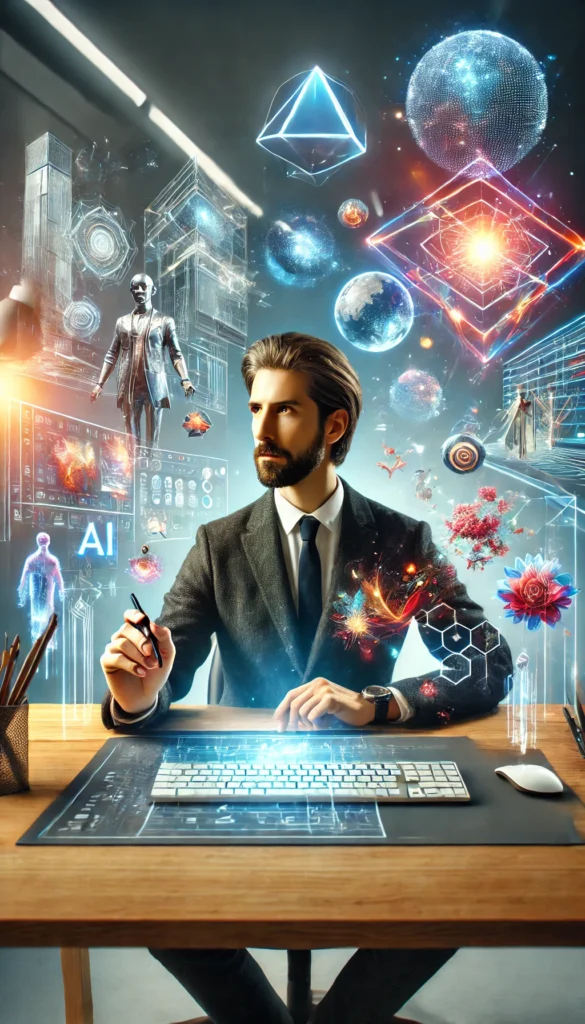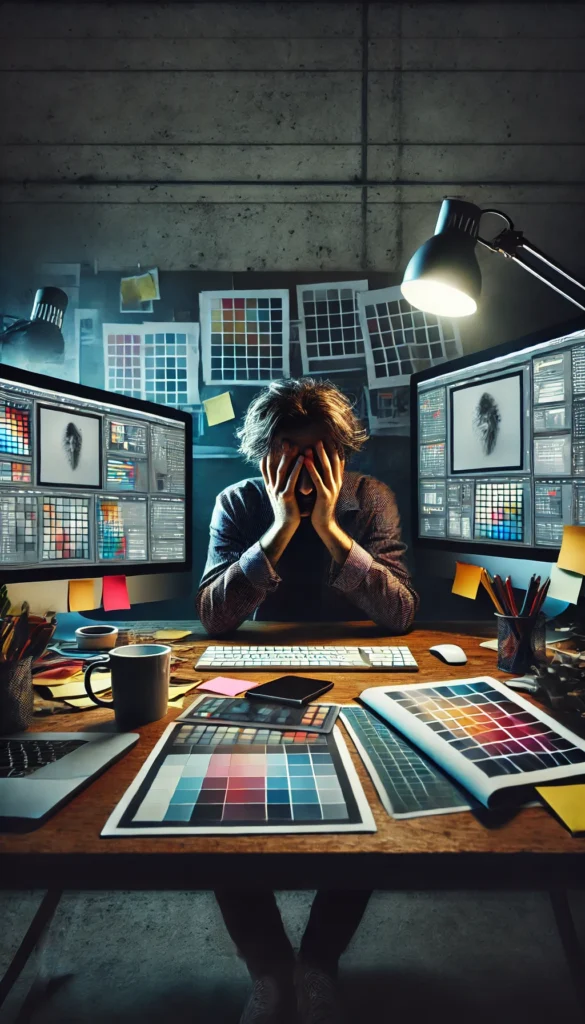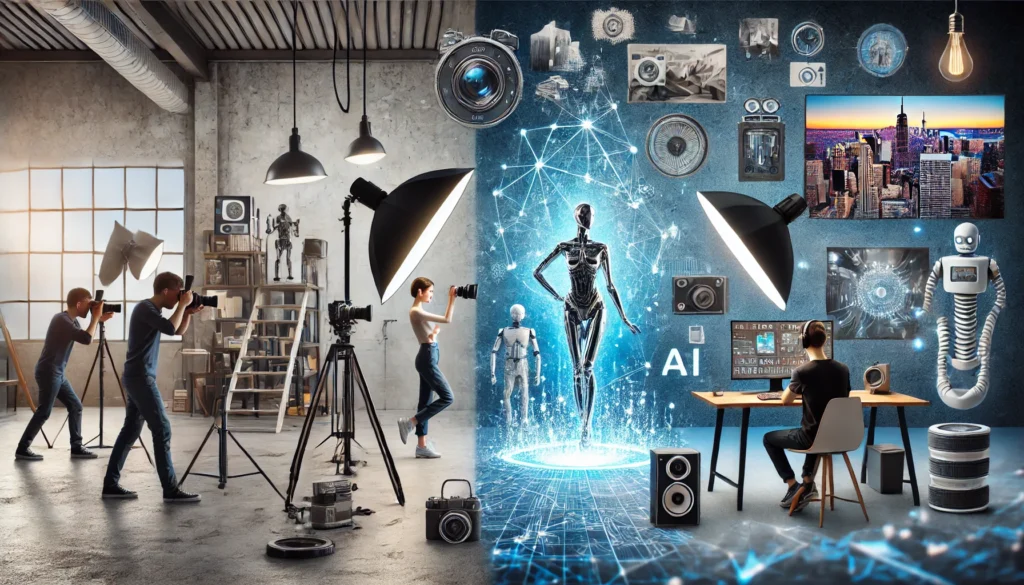The Stock Image Struggle
I’ve spent more time in my early design career digging through stock photo libraries than I care to admit. You know the drill—clicking through page after page, trying to find that one image that almost fits the mood board, tweaking filters to narrow it down, only to end up settling for something “good enough.”
Back then, stock imagery was one of the few ways to get high-quality visuals without a custom photoshoot. It was a necessary tool—but often a frustrating one.
Fast forward to today: with AI tools like DALL·E, Midjourney, and Adobe Firefly, I can generate unique, on-brand imagery in minutes. Need a surreal landscape with two suns? Done. Want a businesswoman smiling in front of a Tokyo skyline at dusk? Easy.
The game has changed. But has it changed everything?
That’s what I want to explore in this post: is stock photography still viable in the age of AI image generation? Or has it finally met its match?
The Rise of AI-Generated Imagery

In the last couple of years, image generation tools powered by AI have gone from fringe experiments to everyday creative companions. What used to take hours of searching—or an entire photoshoot—can now be spun up in seconds with a well-crafted prompt.
Need a perfectly lit product shot? A dreamy sci-fi background? A hyper-specific demographic in a surreal setting? AI’s got you covered.
The barrier to entry is practically gone. Tools like Midjourney, DALL·E, and Stable Diffusion allow anyone—designers, marketers, small business owners—to generate custom visuals on demand. You’re no longer limited to what already exists in a stock library; you can imagine something entirely new.
And it’s not just standalone platforms. Adobe has fully leaned in with Firefly, now integrated directly into Creative Cloud. You can generate backgrounds, extend images, or tweak elements—all from inside Photoshop and Illustrator. No switching tabs. No awkward imports.
It’s powerful. It’s fast. And yeah, it’s kind of addictive.
But the creative industry’s reaction hasn’t been all applause. Not everyone’s thrilled about this new era.
The Creative Industry Reacts

As AI tools started flooding into design workflows, the reactions were… mixed, to say the least.
On one hand, there’s genuine excitement. Designers love saving time, exploring wild concepts without breaking budgets, and skipping the stock photo rabbit hole. AI opens doors for prototyping, ideation, and creating images that would be impossible—or wildly expensive—with traditional means.
But the backlash came just as fast.
Some creatives felt betrayed when Adobe rolled out Firefly features directly into tools like Photoshop. After all, many of those tools were trained—at least in part—on data scraped from the open web. Artists worried their work was used without consent. Others raised flags about style mimicry, job displacement, and the slow erosion of what it means to create something “original.”
Beyond ethics, there’s also the question of legality. Copyright law hasn’t fully caught up with generative AI, which leaves a lot of gray area—especially when it comes to commercial use. Some platforms, like Getty Images, have banned AI-generated content entirely due to concerns about copyright infringement. Others, like Adobe Stock, have started allowing AI-generated images, but only under specific guidelines. It’s a messy, evolving landscape.
And then there’s quality. A lot of AI-generated images look cool at first glance but fall apart under scrutiny. Weird hands, uncanny faces, physics-defying light—sometimes it’s more “fever dream” than “final asset.”
So now we’re in a strange moment: AI is powerful, accessible, and undeniably useful. But it’s also controversial, especially in a field where authorship, originality, and legal clarity matter deeply.
Even so, amid all the noise, traditional stock photography hasn’t gone away. In fact, for many designers, it still plays a crucial role.
Where Stock Still Wins
For all the magic AI promises, there are still moments when nothing beats a good, old-fashioned stock photo.
If you’re going for realism—true, documentary-style photography—stock libraries still offer the gold standard. Real people in real places, captured with professional lighting, composition, and that subtle human touch AI still struggles to replicate. When the goal is to feel authentic, not artificial, stock often delivers.
And let’s talk about consistency. AI excels at one-off imagery, but when you need a cohesive series—same model, same setting, same vibe—stock pulls ahead. Stock platforms let you browse collections by the same photographer or featuring the same talent, which is still tough to replicate with prompt-based generation.
Then there’s the legal safety net. With stock, you know exactly what you’re getting: licensing terms, usage rights, model releases, and commercial clearance. AI-generated content? That’s still a legal gray zone in many ways, especially when used commercially. Until regulations catch up, stock remains the safer bet for clients and campaigns.
Even from a quality perspective, stock holds its ground. Yes, it takes time to find the perfect image—but once you do, you’re getting a photo that was crafted with intention, not just stitched together by an algorithm.
So no, stock isn’t dead. It’s just no longer the only game in town.
When AI Makes More Sense
While stock still has the edge in realism and legal clarity, there are plenty of situations where AI image generation pulls way ahead—and not just for the novelty factor.
First, speed. If you’re working on a tight deadline or need visual assets yesterday, AI lets you create exactly what you want without waiting on a photo shoot or settling for the closest stock approximation. No more, “This will work if I crop out the guy in the background.”
Second, flexibility. You can generate wildly specific images that just don’t exist in stock libraries—think “a robot barista in a 1950s diner wearing a pink apron.” Stock isn’t even trying to help you with that. With AI, you’re only limited by your imagination (and, okay, your prompt-writing skills).
AI also shines during the concept and ideation phase. Need a visual placeholder while pitching a creative direction to a client? Mocking up a landing page? Building moodboards? AI images can communicate a vibe instantly—and if the idea evolves, you can regenerate to match. Fast iteration without spending extra budget.
And finally, cost. For small businesses or solo creators, AI offers a way to generate high-quality visuals without the licensing fees or subscription costs that come with stock libraries. It’s not free—but in the right hands, it can be cost-effective.
So no, AI doesn’t always replace stock—but in the right context, it’s an incredibly powerful creative shortcut.
The Future: Coexistence, Not Replacement
The conversation around AI vs. stock often gets framed like a zero-sum game—one wins, the other dies. But the more likely reality? They’re going to coexist, each evolving to fill different needs in the creative ecosystem.
We’re already seeing signs of this. Major stock platforms like Shutterstock and Adobe Stock are leaning into AI by offering their own generative tools and curated AI content sections. They’re not abandoning stock—they’re adapting to demand. Some even license contributors’ AI-generated work, blending traditional stock with synthetic visuals under clear terms.
On the creative side, workflows are starting to look hybrid. Designers might start with AI for quick mockups or visual exploration, then switch to stock for final assets with legal clarity and realism. Or maybe they generate a background with AI and layer in a real stock subject. The tools don’t have to compete—they can complement each other.
As AI matures, the line between “real” and “generated” will continue to blur. But authenticity, trust, and intentionality will still matter. Clients want to know where visuals come from. They want content that reflects real people, real stories, and real values. That’s where stock keeps its edge.
In short: AI isn’t killing stock. It’s forcing it to level up—and giving creatives more control than ever before.
Final Thoughts: More Tools, More Choices
Stock photography isn’t dead. It’s just not the only option anymore.
AI image generation has opened up a new dimension of creativity—faster, more flexible, and often more fun. But for all its power, it hasn’t fully replaced the depth, realism, and reliability of traditional stock imagery. Instead of choosing one over the other, today’s creatives are learning to use both—strategically.
When I need speed, experimentation, or something totally offbeat, AI is my go-to. But when quality, realism, and licensing matter, I still reach for stock.
Here’s a quick cheat sheet from my own workflow:
✅ When I Use Stock:
⚡ When I Use AI:
We’re no longer limited—we’re equipped. With both stock and AI in your toolkit, creativity gets a lot more interesting.
What about you? Have you started working AI into your creative process, or are you sticking with stock? Drop your thoughts—I’d love to hear how others are navigating this shift.

